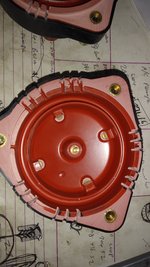Beru rotors had been reboxed OE Genuine, made by Doduco, up through summer 2020. These are NLA, and Beru is now reboxing Facet-brand rotors, with a slightly different part number (EVL-xxxx). Only Doduco rotors are available from Mercedes. These are lacquer coated and have proper-size hex heads in the bolts. AFAICT, the Doducu rotors are the absolute best quality rotor available for the M119.
Beru caps, I don't know who the OEM is, there are no markings to indicate the manufacturer. The label says made in Germany. Detailed photos are on W124performance.com.
Several years ago I had a defective Bosch cap, out of the box. It would misfire only when hot, only at idle. I wasted hours troubleshooting this problem. Although the Bosch caps are OE/OEM, after this bad experience I switched to Beru caps (no problems, yet, as of summer 2024). Allegedly the older OE/Genuine Bosch caps had a clear lacquer (conformal coating?) on them, but they no longer have this... apparent cost-cutting. Now, the dealer caps look identical to the aftermarket Bosch caps, no lacquer coating, just twice the price. [Update - dealer caps no longer have the coating, they appear identical to aftermarket Bosch.]
Only Bosch orange insulators (dust caps) are available now, either OE/dealer or aftermarket. The old black ones you may find on early cars are made by Doduco. It might be coincidence but I've not yet encountered a failed Doduco insulator.
I would love to see photos of an original Doduco cap, to check if it had any ventilation slots, or was totally unvented.

Beru caps, I don't know who the OEM is, there are no markings to indicate the manufacturer. The label says made in Germany. Detailed photos are on W124performance.com.
Several years ago I had a defective Bosch cap, out of the box. It would misfire only when hot, only at idle. I wasted hours troubleshooting this problem. Although the Bosch caps are OE/OEM, after this bad experience I switched to Beru caps (no problems, yet, as of summer 2024). Allegedly the older OE/Genuine Bosch caps had a clear lacquer (conformal coating?) on them, but they no longer have this... apparent cost-cutting. Now, the dealer caps look identical to the aftermarket Bosch caps, no lacquer coating, just twice the price. [Update - dealer caps no longer have the coating, they appear identical to aftermarket Bosch.]
Only Bosch orange insulators (dust caps) are available now, either OE/dealer or aftermarket. The old black ones you may find on early cars are made by Doduco. It might be coincidence but I've not yet encountered a failed Doduco insulator.
I would love to see photos of an original Doduco cap, to check if it had any ventilation slots, or was totally unvented.

Last edited:


 ! (so for now I won't be replacing but i'll hold onto the seals, they were cheap anyway).
! (so for now I won't be replacing but i'll hold onto the seals, they were cheap anyway).




 with some nice colours of the different states of air inside an M119 distributor in the UK. I’ve added more data points. Vertical axis moisture concentration inside distributor. Horizontal temperature of air inside distributor. Run #1 summer. #4 winter 45 mins. #5 winter 9 mins. #7 winter with additional vents.
with some nice colours of the different states of air inside an M119 distributor in the UK. I’ve added more data points. Vertical axis moisture concentration inside distributor. Horizontal temperature of air inside distributor. Run #1 summer. #4 winter 45 mins. #5 winter 9 mins. #7 winter with additional vents.








